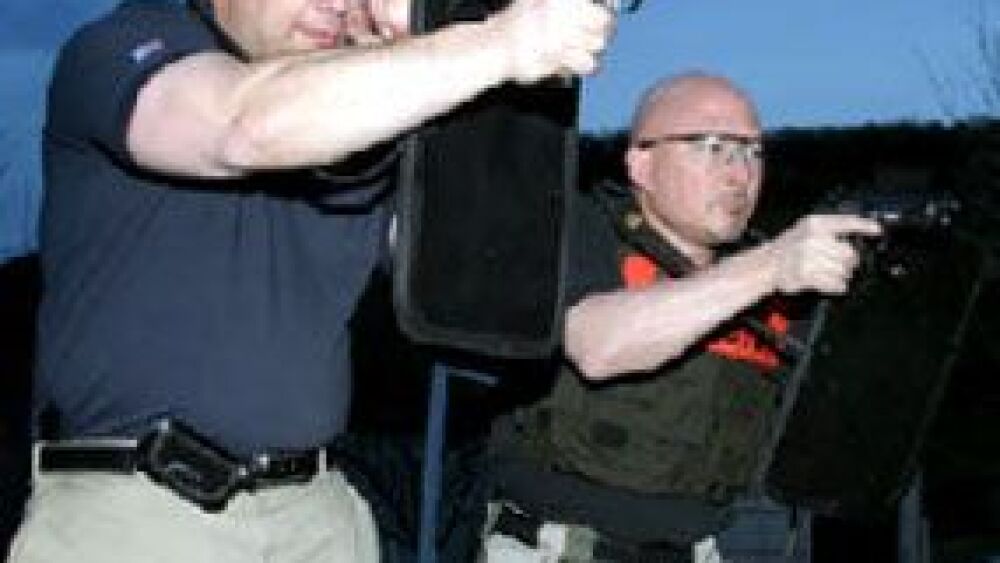In a poll we recently conducted on the Police1 Facebook page, we asked what piece of tactical gear officers would add to their department-issued kit.
While it was amusing to see how many people wanted Chuck Norris added to the PD, and disappointing to see how many agencies still aren’t issuing body armor or TASERs, I was surprised by the absence of one thing — personal ballistic shields.
There are now many options on the market, and given the increasing threat out there on the streets, they seem to me to be a very desirable piece of equipment for patrol.
Know the Basics
First, let me be clear that I’m not talking about those shields widely used in SWAT operations. I’m thinking of patrol shields — everything from small shields which look a little bit like oversized chest plates, to larger rectangular pieces which are stored as rolled up cylinders and quickly unfurl to look like tactical yoga mats.
Probably most important in choosing the correct ballistic shield is being aware of the NIJ standards for threat levels and what each standard stops.
Take into account the ballistic protection ratings/capabilities of each available shield option, measure those against the threats you’re most likely to encounter on the streets, and then begin contemplating costs.
Effective ballistic shields come in a fairly wide variety of sizes, and in both soft and hard armor systems. There are advantages to both, so during any testing and evaluation process begin with an open mind and an honest assessment of needs and not wants.
Most soft armor systems do not have a view port, but typically give a large amount of coverage and are comparatively lightweight. Soft armor shields can be used for breaching, thrown over doors, hung over windows, and deployed atop a countersniper in a prone position.
Generally speaking, soft armor systems are manufactured in NIJ Level 3A ballistic material and some meet blast fragmentation specifications.
Rigid ballistic shields are available in folding models, curved entry models, and flat-panel designs. While many rigid systems have a view port offering the user a clear sight for shooting, some manufacturers choose to omit the view port in order to reduce weight.
Further, some of those rigid systems are so small (not a whole lot bigger than a clipboard), that a viewport is superfluous.
Rigid armor systems are manufactured in both NIJ Level 3A and NIJ Level 3 protection.
Ensure Proper Training
The good news in all of this is that no matter what you determine your needs to be, there is an option on the market which will suit them.
Now, for the bad news: You’ve got to factor into your “total cost of ownership” the additional training you’re going to have to do in order to safely deploy this excellent safety device.
As mentioned above, you have to know what your level of ballistic threat your shield will stop, and what it won’t stop. This is basic stuff, and I hesitate to even mention it, but without this knowledge your shield can be rendered useless in milliseconds.
Deploying a handgun-rated shield into a tactical environment where the threat is armed with a rifle can be a catastrophic failure. Know your gear. Period.
Now that we’ve sharpened the brain, we need to be sure our physical fitness is top tier. These shields are not heavy, but they do weigh something and it’s weight you’d previously not had to carry around on calls.
Those who’ve used them say it can be a bear to carry one for the entire duration of a high-stress encounter. If you do not stay in shape, this alone could kill an out-of-shape officer.
Physically train for upper body and lower body strength and endurance. Take your shield out regularly and take a distant walk through a cleared, empty building.
Get used to carrying it for distance and carrying it with your weapon at the ready — I advocate using a Blue Gun in this type of training scenario.
In addition:
• Practice shooting with the shield, stationery standing, stationery kneeling, moving forward laterally left, laterally in reverse (rescue movement)
• Practice malfunction drills and reloads with your shield — initially practice with dummy rounds and work your way to using ammo
• Practice multiple-shield team movements to enter, clear, and rescue — and don’t forget to practice shooting with shields as a team
Master all of the above in daylight, then do it all over again in low light, while also tactically using lighting or thermal equipment.
Also, don’t forget to train to get rid of it should the need arise. If all of a sudden your dominant hand is out of the fight and you have to switch to support side shooting, you don’t want the shield to become a problem.
In Conclusion
While it should go without saying, body armor must be worn at all times to enhance officer safety and survival. Soft body armor and tactical vests should not be discarded while deploying a shield in a tactical environment. This is not an either-or discussion.
Personal, hand-carryable ballistic shields are tremendous pieces of tactical gear. They can be deployed to every officer, or in a more frugal strategy, to every car (where departments hot-seat their squads).
We’ve come a long way in our effort to get patrol rifles in every squad — there’s a long way still to go, but we’re making progress.
In my opinion, we need to begin making the argument that there should be some type of personal ballistic protection in the trunk of every police car on the streets, too.
Let’s face it, the bad guys are ratcheting up their firepower, mounting attacks with weapons which exceed the protection levels afforded by some body armor. It’s well worth consideration to add to your personal duty inventory a piece of portable, hand-carryable, ballistic protection.
What do you think? Add your comments below.



